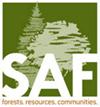基于单株子代试验测量的性能能较好地预测火炬松早期林分产量
IF 1.5
4区 农林科学
Q2 FORESTRY
引用次数: 0
摘要
为了便于利用火炬松的遗传改良,将单株样地或行样地子代试验设计估计的单株体积(生产力)分数与块样地单位面积的林分水平体积进行了比较。在生长和产量试验中建立了代表大量后代测试分数的大量家庭,以将结果推广到由育种计划创建的家庭。子代试验的单株树体积分数与块样地的林分水平体积高度对应,特别是在考虑了立地质量和梭形锈病的风险之后。据估计,子代测试数据的体积分数每增加10分,6岁时林分体积增加3.9 m3 ha-1。提出了一种新的预测模型,该模型包含一个新的统计量——锈蚀风险指数,它是一个家庭在一个新地点的锈蚀发生率,当一个检查站的锈蚀危害可以从历史数据中估计出来时。通过6岁儿童的研究结果证实了绩效评级系统在指导家庭部署决策方面的有效性。所提出的模型是基于冠闭合前6年的数据,随着研究的成熟,将使用旧的测量数据进行更新。研究意义:绩效评级系统(PRS™)是一种成功的工具,可以以更连贯和标准化的方式向土地所有者和森林管理者展示改良火炬松家族的遗传优点。该系统可以很容易地应用于其他林木改良项目,因为它使遗传改良对林业工作者和森林管理者来说是用户友好的。土地所有者可以利用这一制度作出决定,选择适合其具体森林管理目标的改良家庭。种子果园和苗圃管理者也依靠PRS来选择生产的家庭,并作为第三方验证向客户推销其遗传优点。本研究表明,当森林管理者在生产场地种植低梭形锈病风险的速生科时,单位面积的林分蓄积量可以得到提高。在单位面积林分积上,遗传改良对生产力和抗梭形锈病的综合效应显著。本文章由计算机程序翻译,如有差异,请以英文原文为准。
Performance Based on Measurements from Individual-Tree Progeny Tests Strongly Predicts Early Stand Yield in Loblolly Pine
To facilitate the utility of genetic improvement in loblolly pine, individual-tree volume (productivity) scores estimated from single-tree plot or row-plot progeny test designs were compared with stand-level volume per unit area from block plots. A large number of families representing a wide range of progeny test scores for volume were established in growth and yield trials to generalize the results to families created by the breeding program. Individual-tree volume scores from progeny tests strongly corresponded with stand-level volume from block plots, especially after accounting for site quality and the risk of fusiform rust disease. A ten-point increase in the volume score from progeny test data was estimated to increase stand-level volume by 3.9 m3 ha-1 at age 6 years. A prediction model is presented that includes a new statistic, rust risk index, which is the expected rust incidence for a family at a new site when the hazard of rust for a checklot can be estimated from historical data. The study results through age 6 years corroborate the Performance Rating System as effective in guiding family deployment decisions. The models presented are based on pre-crown closure data at 6 years and will be updated with older measurements as the study matures.
Study Implications: The Performance Rating System (PRS™) has been a successful tool for presenting genetic merit of improved loblolly pine families for landowners and forest managers in a more coherent and standardized manner. This system can be easily applied in other forest tree improvement programs, because it makes genetic improvement user-friendly for silviculturists and forest managers. Landowners can use this system to make decisions for selecting improved families suited to their specific forest management objectives. Seed orchard and nursery managers also depend on the PRS to choose the families to produce and as a third-party verification to market their genetic merit to customers. This study demonstrates that higher stand-level volume per unit area can be achieved when forest managers plant fast growing families with low fusiform rust disease risk on productive sites. The combined effect of genetic improvement for productivity and fusiform rust disease resistance is significant on stand-level volume per unit area.
求助全文
通过发布文献求助,成功后即可免费获取论文全文。
去求助
来源期刊

Forest Science
农林科学-林学
CiteScore
2.80
自引率
7.10%
发文量
45
审稿时长
3 months
期刊介绍:
Forest Science is a peer-reviewed journal publishing fundamental and applied research that explores all aspects of natural and social sciences as they apply to the function and management of the forested ecosystems of the world. Topics include silviculture, forest management, biometrics, economics, entomology & pathology, fire & fuels management, forest ecology, genetics & tree improvement, geospatial technologies, harvesting & utilization, landscape ecology, operations research, forest policy, physiology, recreation, social sciences, soils & hydrology, and wildlife management.
Forest Science is published bimonthly in February, April, June, August, October, and December.
 求助内容:
求助内容: 应助结果提醒方式:
应助结果提醒方式:


